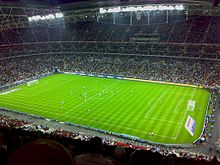International Board fixes soccer field size, halts technology experiments
Sunday, March 9, 2008

The International Football Association Board (IFAB), the body that decides on the laws of the game, has decided to discontinue all experiments involving technology, and for the first time has also decided on the exact size of a soccer field.
Instead of pursuing the idea of using cameras or microchips in the ball to see if it has crossed the goal-line, the International Board wants to see if the introduction of two extra assistant referees can improve the quality of referee's decisions.
FIFA general secretary Jerome Valcke declared: "We have decided to freeze for the time being the goal-line technology and all technology experiments. We will look on these two additional referees and we avoid considering any goal-line technology during this time."
FIFA President Sepp Blatter said the move was necessary to maintain the universal spirit of the game: "We have 260 million people directly involved in the game. If we maintain the laws of the game ... it's so easy to understand ... We have to live with errors, football has to keep its human face."
"We have to maintain the laws of the game in their simplicity. Do you want technical devices to take decisions? That's why, after three years of tests with no conclusions, I am in favour of putting the whole thing on ice," Blatter explained.

UEFA president Michel Platini agreed: "Football should stay human, but two more officials can help, especially around the goal." Platini made the suggestion to freeze all investigations into technology and to try two additional assistants behind each goal.
Blatter said the system using the microchip "was very complicated, needing electrified lines on the field of play and other devices including antennae and when we tested it in Tokyo last year there was one mistake during the seven matches we used as an experiment at the Club World Championship." With regards to the system using cameras, he pointed to "problems with players obscuring the views of the cameras, or of flares or weather conditions."
The system of the extra referees will be tested at an upcoming FIFA or UEFA tournament, and a final ruling is expected at next year's meeting, according to FIFA's Jerome Valcke.
Hawk-Eye, the company that was working on the goal-line technology that is already being used for line calls in tennis, reacted with disappointment: "I'm livid, it is completely out of the blue... A year ago they met and gave us four criteria to meet and we have met all of them, yet they have kicked it out now... We have invested an awful lot of money and now we have no return on that investment," director Paul Hawkins said. He said he was encouraged to continue research on the project only 10 days ago at a private showing for IFAB members at Reading's Madejski Stadium.
While the Welsh FA were also against the idea, the English Football Association supported the use of technology and was hoping to start using it by next season. The FA clubs and referees supported the use of Hawk-Eye technology, said Mike Foster, general secretary of the English Premier League. A spokesperson of the Premier League said that "A lot of time, money and effort has gone into developing a system that meets all the criteria laid down last year." The Scottish and Northern Irish FA also voted in favour of the goal-line technology.
FA chief executive Brian Barwick expressed his disappointment at the annual meeting of the IFAB in Gleneagles, Scotland: "We were in favour of goal-line technology but there will be no more experiments and it will not be back on the agenda next year, or in the foreseeable future."
FIFA President Blatter denied ulterior motives for the decision: "There has been no change of heart. Referees make decisions, not machines... I have defended goal-line technology but it has become clear that such systems are too complicated and very costly. Nor would they necessarily add anything positive to the game and could harm the authority of the referee."
Fixed size for football pitch
Another decision at Gleneagles was to fix the size of a soccer field for men's international matches at 105 x 68 metres. Until now, football's law number 1 stated that the field could be between 100 and 110 metres long and 64 to 75 metres wide. The Welsh Football Association proposed the change, arguing that size variation was an advantage for home teams, who could alter the size of the field against what the visiting team was used to.
The IFAB also agreed to simplify the text of the soccer rules at several points. The last major revision of the text was 11 years ago. The IFAB also condemned violent tackles, warning that "players committing such acts should be banned."
The International Board, established in 1886, is currently made up of eight members, four representing the FIFA and four others from the English, Welsh, Scottish and Northern Irish Football association. Six members need to agree to confirm an IFAB ruling. Next year's meeting will be held in Northern Ireland.
Sources
- Andrew Warshaw. "Fury as goal-line technology plans are shelved" — The Daily Telegraph, March 9, 2008
- Associated Press. "FIFA's International Board agrees to halt all experiments with technology in soccer" — International Herald Tribune, March 8, 2008
- "Fifa halts goal-line experiments" — BBC Sport, March 8, 2008
- Mark Ledsom (Reuters), Alison Wildey. "International Board to consider standard sized pitches" — International Herald Tribune, February 13, 2008
- "Goal-line technology put on ice" — FIFA, March 8, 2008
- Mike Collett (Reuters). "FIFA ends goalline idea after inconclusive tests" — The Guardian, March 8, 2008

